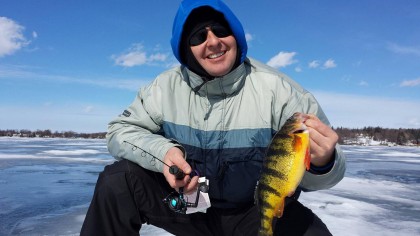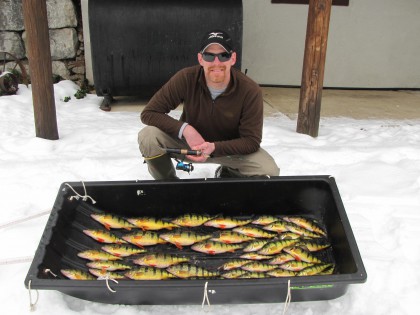
Each winter the arrival of safe ice on local lakes is something keenly anticipated by many. As deer season comes to an end and the Holidays arrive, hardcore hard water anglers can be found preparing gear, watching the thermometer and soliciting reports of safe ice from fellow anglers. For those that do not ice fish the following series of blogs will likely not entertain. For those who do ice fish but are new to the pastime, I will share with you some things I have learned in over 30 years of exploring frozen lakes in search of fish. Throughout the following posts I will define ice fishing terms and explain ice fishing techniques.
Most lake anglers in Upstate New York have their boats put away by Thanksgiving. A hardy few, who know how very good the fishing is on the lakes in early winter, will launch whenever open water conditions are tolerable. To such diehards whats considered “tolerable” is not-so-much to most. But to these guys, filling a bucket with jumbos is what it is all about and trumps hanging out in a tree stand any time. I walk the fine line between Autumn angler and afflicted whitetail hunter. Yet my boat is almost always in the barn by Thanksgiving. And by late December, with rifle cleaned and put away, I am in search of early ice.
Early ice on the lakes and bays is ice that is fresh, usually black or clear and safe to walk on. It is ice that has only been “set-up” for a week more or less. While early ice is perceived as inherently dangerous by ice anglers, the bulk of ice fishing accidents happen during the mid-ice and late-ice parts of the season (I will explain some of the reasons why in future blogs). Early ice has to be at least an unvaried three inches in thickness to be safe enough for me to walk on. I won’t guide anglers on less than five inches of unvaried ice however. It is my “working” ice fishing insurance policy.
Early winter fishing on the lakes is excellent. The angling pressure the fish experienced all Summer and Autumn is now a distant memory. But the strong appetite the fish developed as waters turned increasingly colder is still in full effect. Schooling fish that roam the basins of big lakes in late December are hungry! Water temperatures have stratified at this time of year and vary only a little each day before a thin formation of ice forms. This new “roof” above the fish on a shallow lake or bay makes the fish active and can sometimes trigger large schools to strap on the food bag for days! Early ice can often provide some of the best fishing of the entire year!

Declining water temperatures puts warm water fish like walleye and perch on a constant search for food. This is one of the most important factors in early winter that cause fish to school up heavy. Safe ice enables anglers to roam and search for these hungry schooled fish. The somewhat static and vertical presentation of an ice anglers bait to active panfish is deadly! Thats why ice fishing is addicting. Because when it is good, as it so often is when the ice is newly formed, it creates the opportunity to hammer the panfish!


